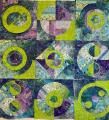quilting with bias outside edges
#11
Senior Member
Join Date: Aug 2013
Location: AR/NM
Posts: 358
I stabilize outside bias edges with featherweight interfacing fusible before I cut the blocks. It saves a lot of frustration later on. Eample: If I cut an X in a square. I put strips of interfacing making the X before cutting. I buy different widths of strips on a roll.
#12
Senior Member
Join Date: Jun 2015
Location: Rosemere, Quebec, Canada
Posts: 322
The little arm on the walking foot has two "fingers": When you install the walking foot, the top finger has to be above the needle clamp and the bottom finger goes underneath. It can be tricky to do when you're trying to attach the foot itself with the thumb screw. I was distracted yesterday and didn't notice that the little arm wasn't properly positioned. It made quite a racket. It should be noted that the Juki walking foot, even when properly installed, is quite noisy ...
#13
Power Poster
Join Date: Dec 2008
Location: Western Wisconsin
Posts: 12,930
In addition to stabilizing the edges with a line of stitches (I would use long stitches in case you have to release some later) and using a walking foot, it helps a lot to heavily starch the top and backing. If you have not yet sandwiched, a 1:1 solution of Sta-Flo and water on the backing fabric creates a heavy starching. For the top you can do multiple layers of spray basting. If the quilt is already sandwiched, doing several layers of spray starching on top and backing will still help a lot. To spray starch, lay the sandwich out on a large flat sheet, spray from the edges towards the center to minimize over-spray, and turn a fan on to speed drying between layers. Starching stabilizes the fabric, greatly reducing "creep", distortions, tucks and puckering when machine quilting.
#14
Super Member
Join Date: Jul 2014
Location: Illinois
Posts: 2,140
I agree with those who suggested starting with stay stitching within your 1/4" seam allowance for binding (those stitches don't get removed -- use same thread color as your binding). I'd do that before layering the sandwich. Once the sandwich is layered, I'd probably do a bit of extra basting (or glue baste it) so I knew it was nice & secure before starting on the quilting. I wouldn't worry so much about the quilting itself stretching those edges, but rotating the quilt has the possibility of stretching the bias edges if they aren't secured first.
#15
Senior Member
Thread Starter
Join Date: Oct 2012
Posts: 778
These are such helpful ideas. I'm sure I am not the only person in history who has blithely followed directions to bisect a square into right triangles, without thinking through where that bias edge is going.
I have never starched a top, Prism, but your directions are so clear, I think I could do it. It isn't sandwiched yet.
Hugs,
Charlotte, feeling less despairing
I have never starched a top, Prism, but your directions are so clear, I think I could do it. It isn't sandwiched yet.
Hugs,
Charlotte, feeling less despairing
#16
A very experienced and award winning quilter friend of mine told me to always hand baste around the edges through all 3 layers before quilting on domestic machine....even without bias outside edges. You can also machine stay stitch around the edges of the quilt top 1/8 inch from edge also. Many quilters I know do this religiously.
#17
Super Member
Join Date: Jun 2011
Location: Illinois
Posts: 9,018
Basting will secure those bias edges....but the problem in my mind is that those setting triangles were incorrectly created and pieced onto that top. I have always cut that square ( whatever size needed), then cut the two diagonals, but the outside straight of grain of that square is what is the edge of the top. The bias cuts I created with those two diagonals are sewed onto the blocks that are on point, corners done with hsts.
#18
Power Poster
Join Date: Jun 2011
Location: Southern California
Posts: 19,131
Tartan is so correct about doing a basting stitch around the edges in case you need to remove them. I have stitched diagonally on many quilts but I always had the setting triangles be the straight of grain on the outside edge. My avatar is stitched diagonally thru the squares in each quarter of the quilt.
#19
I am currently doing the FMQ-ing on a quilt that is set on point. I'm almost to the border...is it still useful to sew all the way around the quilt before I finish the borders, or is it too late for it to be of help?
Watson
Watson
#20
Super Member
Join Date: Jul 2014
Location: Illinois
Posts: 2,140
If you pin basted your quilt, I'd still do it. I baste by hand within the seam line because it keeps the edge from flipping & stitching to the back, but it's personal preference. It also can help the fabric lay just a bit flatter. Typically, as soon as I finish my pin basting, I pull off the masking tape, grab a basting needle & some junk thread and take care of the basting.
Thread
Thread Starter
Forum
Replies
Last Post
craftybear
Links and Resources
11
02-15-2011 09:33 PM
craftybear
Links and Resources
0
01-30-2011 09:14 PM
craftybear
Main
14
07-05-2010 07:31 PM





